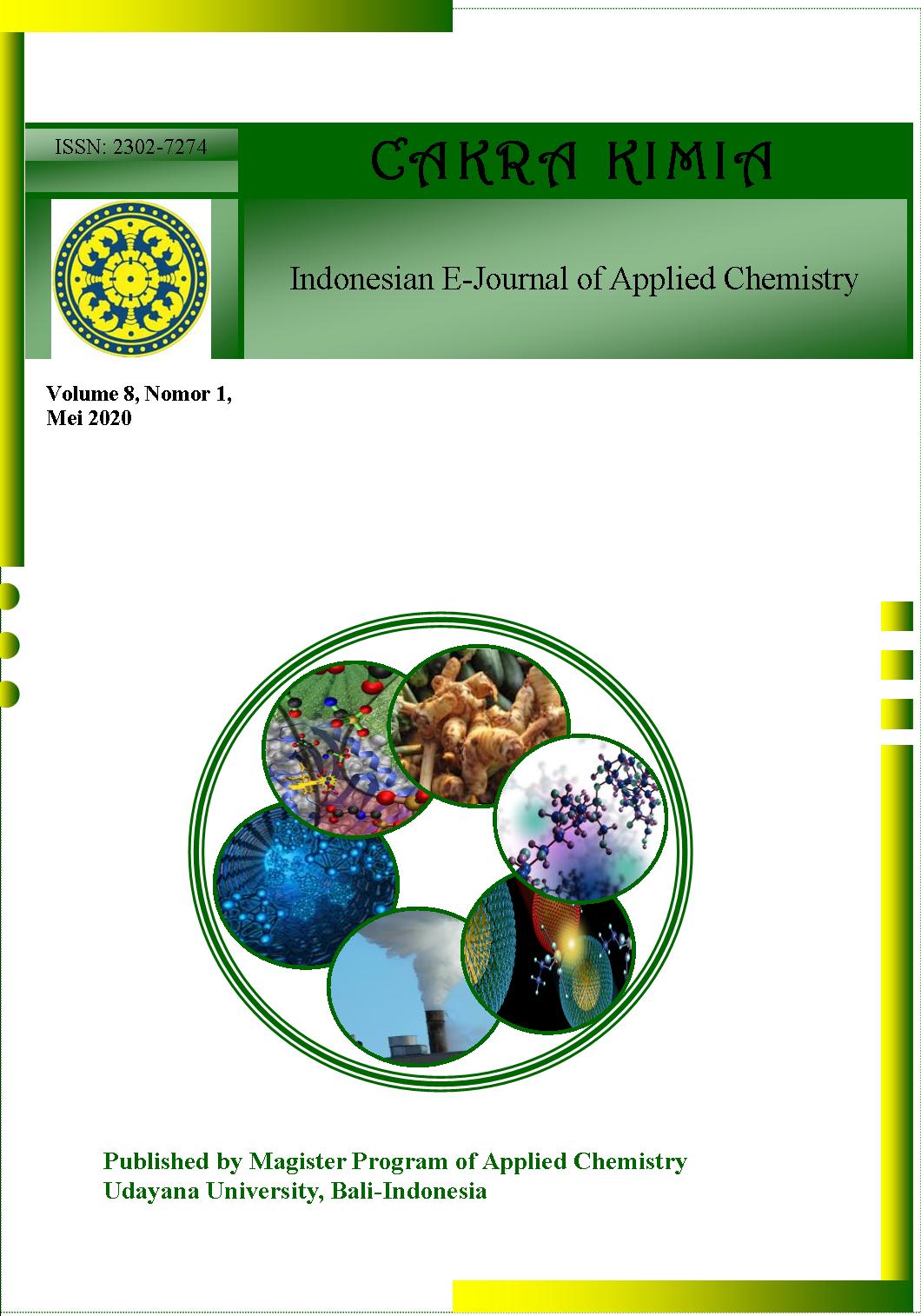PENGARUH SUHU KALSINASI TERHADAP KARAKTERISTIK DAN AKTIVITAS FOTOKATALIS N/TiO2 PADA PENJERNIHAN LIMBAH BATIK TENUN IKAT KEDIRI
Abstract
ABSTRAK: Pembuatan batik tenun ikat di Bandar Kidul, Kediri tak lepas dari penggunaan pewarna sintesis yang mengandung bahan kimia. Hingga saat ini, industri batik tenun ikat Kediri masih belum bisa mengolah limbah pewarnaan sintetis sehingga mencemari lingkungan sekitar. Salah satu metode yang dapat digunakan untuk mereduksi limbah pewarna sintetis adalah fotokatalisis dengan menggunakan material semikonduktor fotokatalis. Material semikonduktor fotokatalis yang cocok digunakan dalam pengolahan limbah batik adalah TiO2. Material TiO2 bersifat non toksik dan ramah lingkungan. Efektifitas fotokatalis dapat ditingkatkan dengan menambahkan unsur lain, dalam hal ini adalah nitrogen. Nitrogen memiliki ukuran yang tidak jauh berbeda dengan oksigen dan juga memiliki energi ionisasi yang kecil. Penelitian ini merupakan studi awal untuk mempelajari pengaruh variasi suhu kalsinasi (300°C, 400°C, 500°C, 600°C dan 700°C) terhadap N/TiO2 untuk penjernihan limbah tenun ikat Kediri. Penelitian ini bertujuan untuk mengetahui suhu kalsinasi optimal yang diperlukan dalam sintesis material fotokatalis, sehingga dapat digunakan untuk menjernihkan limbah batik tenun ikat Kediri. Berdasarkan hasil Penelitian diketahui bahwa fasa dari material semikonduktor N/TiO2 dengan variasi suhu 300-700°C yang terbentuk masih dalam fasa anatase. Semakin tinggi suhu kalsinasi maka intensitas pada difraktogram akan semakin menurun dan ukuran kristal yang diperoleh pada N/TiO2 juga semakin kecil kecuali pada suhu 700°C. Semakin tinggi suhu kalsinasi maka energy band gap yang dihasilkan akan semakin kecil, kecuali pada suhu 600-700°C. Berdasarkan hasil karakterisasi dan aplikasi diketahui bahwa material N/TiO2 paling optimal dihasilkan pada suhu kalsinasi 500°C.
ABSTRACT: The manufacture of woven batik industry at Bandar Kidul, Kediri is inseparable from the use of synthetic dyes containing chemicals. Until now, the Kediri woven batik industry has not been able to process synthetic dye waste which pollute the environment. Photocatalysis is method that can be used to reduce synthetic dye waste using photocatalyst semiconductor materials. Photocatalyst semiconductor material which is suitable for use in treating the woven batik waste is TiO2 since it is non-toxic and environmentally friendly. The effectiveness of the photocatalyst can be increased by adding another element which is in this study using nitrogen. Nitrogen has a size that is not much different from oxygen and also has a small ionization energy. This research is a preliminary study to know the effect of calcination temperature (300°C, 400°C, 500°C, 600°C and 700°C) on N/TiO2 materials for the purification of woven batik industry, Bandar Kidul, Kediri. The purpose of this study is to find out the optimal calcination temperature needed in the synthesis of photocatalyst material using wet impregnation, so that it can be used to purify the woven batik waste. Based on the research results, the phase of the N/TiO2 semiconductor materials formed with the range of temperature of 300-700°C is still an anatase phase. The higher the calcination temperature, the lower the intensity on the diffractogram and the sizes of the crystals are also smaller except at temperature of 700°C. The higher the calcination temperature, the smaller the energy band gap produced except at temperatures of 600-700°C. Based on the results of characterization and application, it is known that the most optimal material produced is N/TiO2 with a temperature variation of 500°C.
Downloads
References
[2] Sitanggang, P. Y., 2017. Pengolahan Limbah Tekstil Dan Batik di Indonesia,” J. Tek. Lingkung., 1(12) :1–10
DOI: 10.5281/zenodo.1133991.
[3] Gümüş D., and Akbal F., 2011. Photocatalytic degradation of textile dye and wastewater. Water. Air. Soil Pollut., 216(1–4): 117–124
doi: 10.1007/s11270-010-0520-z.
[4] Khalik W. F., Ho, L.N., Ong, S. A., Wong, Y. S., Yusoff, N. A., and Ridwan, F., 2015. Decolorization and Mineralization of Batik Wastewater through Solar Photocatalytic Process,” Sains Malaysiana, 44(4): 607–612
[5] Hameed, B. H., and Ahmad, A. A., 2009. Batch Adsorption of Methylene Blue from Aqueous Solution by Garlic Peel, an Agricultural Waste Biomass,” J. Hazard. Mater., 164(2–3): 870–875
doi: 10.1016/j.jhazmat.2008.08.084.
[6] Kitture, R., Koppikar, S. J., Kaul-Ghanekar, R., and Kale, S. N., 2011. Catalyst Efficiency, Photostability and Reusability Study of ZnO Nanoparticles in Visible Light for Dye Degradation, J. Phys. Chem. Solids, 72(1): 60–66,
doi: 10.1016/j.jpcs.2010.10.090.
[7] Sudamalla, P., Matheswaran, M., and Saravanan, P., 2012. Optimization of Operating Parameters Using Response Surface Methodology for Adsorption of Crystal Violet by Activated Carbon Prepared from Mango Kernel,” Sustain. Environ. Res., 22(1): 1–7
[8] Jin, R. F., Zhou, J. T., Zhang, A. L., and Wang, J., 2008. Bioaugmentation of The Decolorization Rate of Acid Red GR by Genetically Engineered Microorganism Escherichia coli JM109 (pGEX-AZR), World J. Microbiol. Biotechnol., 24(1): 23–29, doi: 10.1007/s11274-007-9433-4
[9] Ponraj, M., Jamunarani P., and Zambare, V., 2011. Isolation and Optimization of Culture Conditions For Decolorization of True Blue Using Dye Decolorizing Fungi,” Appl. Sci., 2(2): 270–277
[10] Ahmad, A. L., Harris W. A., S. S., and Ooi B. S., 2002. Removal of Dye From Wastewater of Textile Industry Using Membrane Technology, J. Teknol., 36(1)
doi: 10.11113/jt.v36.581.
[11] Fersi, C., Gzara, L., and Dhahbi, M., 2005. Treatment of Textile Effluents by Membrane Technologies,” Desalination, 185(1–3): 399–409
doi: 10.1016/j.desal.2005.03.087.
[12] Chantes, P., Jarusutthirak, C., and Danwittayakul, S., 2015. “A Comparison Study of Photocatalytic Activity of TiO2 and ZnO on the Degradation of Real Batik Wastewater,” in International Conference on Biological, Environment and Food Engineering (BEFE-2015),
doi: 10.15242/iicbe.c0515033.
[13] Agustina, T. E., Bustomi, A., and Manalaoon, J., 2016. Pengaruh Konsentrasi TiO2 dan Konsentrasi Limbah pada Proses Pengolahan Limbah Pewarna Sintetik Procion Red dengan Metode UV/Fenton/TiO2, J. Tek. Kim., 22(1): 65–72
[14] Rosanti, A. D., 2014. “Pengaruh Variasi Konsentrasi Garam FeCl3.6H2O, Suhu Kalsinasi, dan pH Terhadap Karakter Fe-TiO2 yang Disintesis Menggunakan Metode Sol-Gel,” Universitas Gadjah Mada,
[15] Vaiano, V. Sacco, O., Sannino, D., 2014. N-doped TiO2/s-PS Aerogels for Photocatalytic Degradation of Organic Dyes in Wastewater Under Visible Light Irradiation,” J. Chem. Technol. Biotechnol., 89(8): 1175–1181
doi: 10.1002/jctb.4372.
[16] Wardhani, S., Bahari, A., and Khunur, M. M., 2016. Aktivitas Fotokatalitik Beads TiO2-N/Zeolit-Kitosan Pada Fotodegradasi Metilen Biru (Kajian Pengembanan, Sumber Sinar dan Lama Penyinaran), J. Enviromental Eng. Sustain. Technol., 3(2): 78–84
doi: 10.21776/ub.jeest.2016.003.02.2.
[17] Pinna, F., 1998. Supported Metal Catalysts Preparation, Catal. Today, 41(1–3): 129–137
doi: 10.1016/S0920-5861(98)00043-1.



 Petunjuk Penulisan
Petunjuk Penulisan
